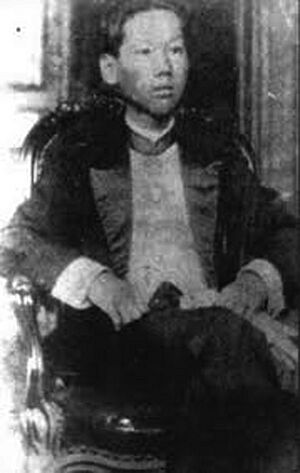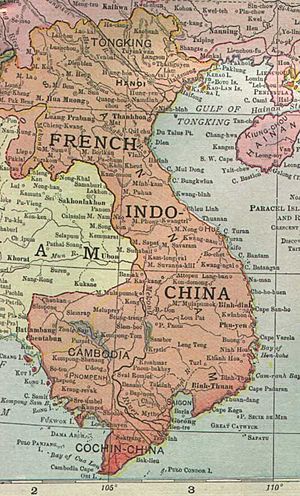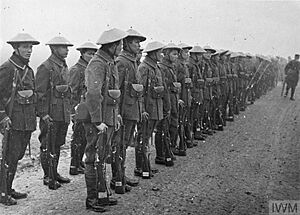History of Vietnam during World War I facts for kids
At the start of World War I, Vietnam was under French control, even though it still had its own Nguyễn dynasty emperor. It was part of a larger French colony called French Indochina. During the war, France wanted to use Vietnam's natural resources and people to help with the war effort. Because of this, they stopped any Vietnamese groups who wanted independence. Many Vietnamese later fought in the war.
Contents
Vietnam's Role in World War I
Vietnamese Soldiers and Workers in Europe
When France joined World War I, French leaders in Vietnam forced thousands of Vietnamese men to become soldiers or workers in Europe. This led to some uprisings in different parts of Vietnam, like Tonkin and Cochinchina.
Almost 100,000 Vietnamese men were sent to Europe. They fought on the French battlefronts or worked as laborers. Some battalions fought bravely and many lost their lives in famous battles like the Somme and Verdun. Other Vietnamese troops also served in places like the Balkans and the Middle East.
When these soldiers returned home, they had seen new ideas about freedom and independence. They had fought for France, but their own country was still controlled by France. This made many of them unhappy. Because of this, many joined the Vietnamese nationalist movement, which aimed to overthrow French rule.
How Vietnamese Forces Were Organized
- Further information: Tirailleurs indochinois
A total of 92,311 Vietnamese men from Indochina served France during the war. They were divided into different groups:
- 4,800 men were in combat battalions (fighting units).
- 24,212 men were in transit battalions (moving troops).
- 9,019 men worked as colonial medical staff.
- 48,981 men worked as colonial laborers.
Two main Vietnamese combat battalions, the 7th and 21st Bataillons de Marche Indochinois, served in France.
The 7th Battalion was formed in Tonkin in February 1916. They arrived in France in September and trained until April 1917. They first saw action in May 1917 during the 2nd Battle of the Aisne. Their job was to resupply troops and organize captured areas. In June 1918, they helped fight off a strong German attack. They left France in February 1919 and the unit was disbanded in Vietnam.
The 21st Battalion was formed in France in December 1916 from Vietnamese soldiers already there. From April 1917, they worked on road repair, airfields, and drainage on the battlefields. They also served in frontline trenches in the Vosges mountains and near Reims. This battalion was disbanded in April 1919.
Two other combat battalions, the 1st and 2nd, served in Salonika (Greece).
Many laborers from Indochina also worked in France during the war:
- 1915: 4,631 workers
- 1916: 26,098 workers
- 1917: 11,719 workers
- 1918: 5,806 workers
- 1919: 727 workers
When the war began, many French officers of the tirailleurs tonkinois and tirailleurs annamite (Vietnamese riflemen) were called back to France. Some Tonkinese riflemen later served on the Western Front near Verdun.
In 1915, a battalion of the 3rd Regiment of Tonkinese Rifles was sent to China. They guarded the French area in Shanghai. In Vietnam, other tirailleurs helped put down a mutiny in Thai Nguyen in 1917. In August 1918, three companies of tirailleurs tonkinois were sent to Siberia as part of an Allied effort after the Russian Revolution.
Vietnamese Casualties
Vietnamese soldiers fought and died for France. Their involvement and losses helped shape Vietnam's national identity. In 2004, a journalist reported that over 12,000 Vietnamese military personnel died during World War I. The Vietnamese people also had to pay extra heavy taxes to help France pay for the war. There is a war memorial at Saint-Pierre cemetery in Aix-en-Provence, France, that remembers the Vietnamese soldiers who died.
Life in Vietnam During the War
Changes and Challenges at Home
Through contact with Europeans and their writings, some Vietnamese learned about new ideas like national independence and revolution. Vietnam also gave France 184 million piasters (a type of money) in loans and 336,000 tons of food. These demands were very hard on Vietnam, especially because farming was badly affected by natural disasters from 1914 to 1917.
Even though the Vietnamese independence movement was strong, it didn't have one big organization across the country. So, it couldn't fully use France's wartime problems to start large uprisings. Older movements had weakened, and new social groups were not yet strong enough to lead big campaigns.
Uprisings Against French Rule
Many revolts against French rule happened in Vietnam during the war. However, the French easily stopped all of them. In May 1916, the 16-year-old emperor, Duy Tân, secretly left his palace. He planned to join an uprising of Vietnamese troops organized by Thái Phiên and Trần Cao Vân. But the French found out about the plan. The leaders were arrested and executed. Emperor Duy Tân was removed from power and sent away to Réunion Island in the Indian Ocean.
One of the most important uprisings during this time happened in the northern province of Thái Nguyên. About 300 Vietnamese soldiers revolted. They freed 200 political prisoners and armed them, along with hundreds of local people. The rebels controlled the town of Thái Nguyên for several days. They hoped for help from Chinese nationalists, but no help came. The French soon took back the town and captured most of the rebels.
Around this time, a young man named Hồ Chí Minh arrived in the United States. He stayed there for a few years, doing simple jobs to support himself. He learned English and about American culture. He felt a connection with African Americans in New York, especially in Harlem. Years later, when he declared Vietnam's independence on September 2, 1945, in Hanoi, Hồ Chí Minh directly quoted from the American Declaration of Independence.
Patriotic Writings and Secret Groups
In 1917, a journalist named Phạm Quỳnh started publishing a journal called Nam Phong in Hanoi. It was written in quốc ngữ, the Vietnamese writing system using the Latin alphabet. This journal discussed how Vietnam could adopt modern Western ideas without losing its own culture. By World War I, quốc ngữ was used to spread not only Vietnamese, Chinese, and French classic writings but also new Vietnamese nationalist literature. This new literature often focused on social comments and criticism.
In Cochinchina, patriotic activities often took place through secret societies. The most important one was the Thiên Địa Hội (Heaven and Earth Association). Its groups were found in many provinces around Saigon. These groups often mixed politics with religion. One of their main goals was to punish Vietnamese people who worked for the French.
A movement led by a former Buddhist monk, Phan Xích Long, was connected to these secret societies. In 1913, his followers, wearing white clothes and turbans, attacked cities with simple weapons. Phan Xích Long was eventually captured and executed by the French. In 1916, secret societies in Cochinchina tried to attack several French administrative centers. This included the main prison in Saigon and the home of the French governor. On the night of February 14, 1916, thousands of people with knives and special amulets entered Saigon. They fought French police and soldiers, but the French managed to defeat them.
The French government harshly stopped these independence movements. At the same time, they tried to calm down the Vietnamese elite by offering small reforms. They also promised bigger reforms after the war. However, these promises were never kept. France managed to keep control of Vietnam during the war mainly because the independence movement was not yet strong enough. There were patriots who wanted independence, but the new social groups were still developing. They could not give the movement the energy and direction it needed. It took many more years for these forces to grow and for the independence movement to become much stronger.
After the War
After World War I, foreign companies invested a lot more money in Vietnam. This led to big changes. Coal mines grew in the North, and rubber plantations expanded in Central and South Vietnam. Rice farmers in the south also produced much more. These changes created a working class, a wealthy landlord class, rice exporters in Saigon, and a modern group of educated people.
An important change in the early 1900s was the increased use of quốc ngữ in northern Vietnam. Many new journals and newspapers were printed using this writing system. Quốc ngữ publications had existed in Cochinchina since 1865. But in 1898, the French government made a rule. It said that no one could publish periodicals in quốc ngữ or chữ nôm (another Vietnamese writing system) without permission, unless they were French citizens. In 1913, Nguyễn Văn Vĩnh successfully published Đông Dương Tạp Chí (Indochinese Review). This journal was against old traditions but supported France. He also started a publishing house that translated Vietnamese classics like the poem "The Tale of Kieu" into quốc ngữ. Nguyễn Văn Vĩnh's publications helped make quốc ngữ much more popular in Annam and Tonkin.
In the years right after World War I, the Vietnamese independence movement in Cochinchina, led by scholars, became less active for a while. This was partly because the French had tighter control. Also, French-educated Vietnamese people became more involved. During the war, there was less French investment and fewer imports to Vietnam. This created chances for Vietnamese businesspeople. They started working in light industries like rice milling, printing, and textile weaving. The French government also sold large areas of land in the Mekong Delta cheaply to people who wanted to buy and sell land for profit. This led to more wealthy Vietnamese landowners. All these factors together led to the rise of a rich Vietnamese elite in Cochinchina. This group was pro-French but felt frustrated because they lacked political power and status.
Notable Individuals
- Đỗ Hữu Vị (vi), known as the first Vietnamese person to fly a fighter aircraft.






